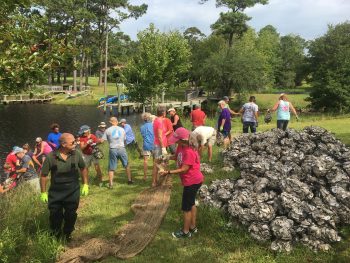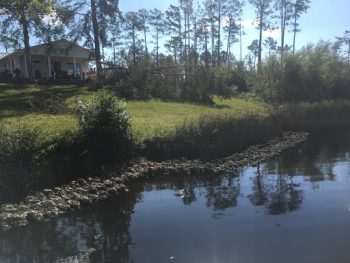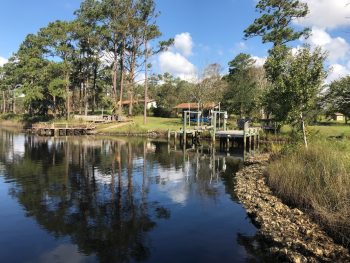In late August, the North Carolina Coastal Federation held a living shoreline workday where staff and volunteers worked together to complete a living shoreline in Starkey Creek using bags of recycled oyster shells. This shoreline will protect the shore from erosion and create habitat for many marine creatures including oysters, which help filter and clean the water.
 The newly completed shoreline lives next to another 125-foot living shoreline on a neighboring private property that was completed by the federation and Carolina Silvics, Inc. The process for building the additional 180-foot living shoreline on the private property started back in June 2017 and was completed throughout the summer this year with several volunteer workdays. Participants involved in these workdays included volunteers from Big Rock Sports, Carteret Community College, Duke Environmental Leadership Master of Environmental Management (DEL-MEM) program and community volunteers from surrounding areas.
The newly completed shoreline lives next to another 125-foot living shoreline on a neighboring private property that was completed by the federation and Carolina Silvics, Inc. The process for building the additional 180-foot living shoreline on the private property started back in June 2017 and was completed throughout the summer this year with several volunteer workdays. Participants involved in these workdays included volunteers from Big Rock Sports, Carteret Community College, Duke Environmental Leadership Master of Environmental Management (DEL-MEM) program and community volunteers from surrounding areas.
“When we see all these strangers who come together to work hard to try and save a little bit of our coast, it makes us think that maybe we can save the world,” said homeowners Hank and Sue Nehring.
Although this living shoreline was built on private property, the creation of any living shoreline will have public benefits. This project was completed in public trust waters and encourages greener shorelines for neighbors. It will also benefit the wildlife an water quality of Starkey Creek and White Oak River.
This living shoreline was created as part of a partnership with the National Oceanic and Atmospheric Administration (NOAA) and the North Carolina Soil and Water Conservation. The project was funded by the NOAA Coastal Ecosystem Resiliency Grants Program and N.C. Soil and Water Conservation Community Conservation Assistance Program. Through this partnership, homeowners are able to apply for assistance to build living shorelines and promote healthy waters all along our coast.

Starkey Creek living shoreline after Florence

Starkey Creek living shoreline after Florence
During Hurricane Florence, the living shoreline remained stable and is still intact after the storm. Living shorelines prove to be a more natural and effective alternative structure.
For more information about living shorelines visit nccoast.org/livingshorlines or the Living Shorelines Academy.
